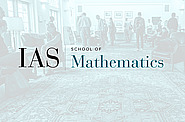Seminars Sorted by Series
Computer Science/Discrete Mathematics Seminar II
Sep
30
2014
Oct
07
2014
Computer Science/Discrete Mathematics Seminar II
Monotone submodular maximization over a matroid
10:30am|S-101
Oct
14
2014
Computer Science/Discrete Mathematics Seminar II
Sampling-based proof of the quasipolynomial Bogolyubov-Ruzsa theorem and algorithmic applications
10:30am|West Bldg. Lect. Hall
Oct
21
2014
Oct
28
2014
Computer Science/Discrete Mathematics Seminar II
Exponential separation of information and communication
10:30am|S-101
Nov
04
2014
Computer Science/Discrete Mathematics Seminar II
Sign rank, spectral gap and VC dimension
10:30am|S-101
Nov
11
2014
Computer Science/Discrete Mathematics Seminar II
Asymptotic expansions of the central limit theorem and its applications
10:30am|S-101
Nov
18
2014
Computer Science/Discrete Mathematics Seminar II
Toric origami manifolds and origami templates
10:30am|S-101
Nov
25
2014
Computer Science/Discrete Mathematics Seminar II
Sum-of-squares lower bounds for the planted clique problem
10:30am|S-101
Dec
02
2014
Computer Science/Discrete Mathematics Seminar II
Taming the hydra: the Word Problem, Dehn functions, and extreme integer compression
10:30am|S-101
Dec
09
2014
Computer Science/Discrete Mathematics Seminar II
More on sum-of-squares proofs for planted clique
10:30am|S-101
Jan
20
2015
Computer Science/Discrete Mathematics Seminar II
Small value parallel repetition for general games
Ankit Garg
10:30am|S-101
Jan
27
2015
Feb
03
2015
Computer Science/Discrete Mathematics Seminar II
Dimension expanders via rank condensers
10:30am|S-101
Feb
10
2015
Computer Science/Discrete Mathematics Seminar II
How to round subspaces: a new spectral clustering algorithm
10:30am|S-101
Feb
17
2015
Computer Science/Discrete Mathematics Seminar II
The log-concavity conjecture and the tropical Laplacian
10:30am|S-101
Feb
24
2015
Mar
03
2015
Computer Science/Discrete Mathematics Seminar II
Whitney numbers via measure concentration in representation varieties
Karim Adiprasito
10:30am|S-101
Mar
10
2015
Computer Science/Discrete Mathematics Seminar II
Chernoff bounds for expander walks
10:30am|West Bldg. Lect. Hall
Mar
17
2015
Computer Science/Discrete Mathematics Seminar II
Average-case lower bounds for formula size
10:30am|S-101
Mar
24
2015
Computer Science/Discrete Mathematics Seminar II
Tractability as compressibility
Dimitris Achlioptas
10:30am|S-101
Mar
31
2015
Computer Science/Discrete Mathematics Seminar II
Kolmogorov width of discrete linear spaces: an approach to matrix rigidity
10:30am|S-101
Apr
07
2015
Computer Science/Discrete Mathematics Seminar II
Interleaved products in special linear groups: mixing and communication complexity
10:30am|S-101
Sep
22
2015
Computer Science/Discrete Mathematics Seminar II
Explicit two-source extractors and resilient functions II
10:30am|S-101
Sep
29
2015
Oct
06
2015
Computer Science/Discrete Mathematics Seminar II
Invariants of random knots
Chaim Even Zohar
10:30am|West Bldg. Lect. Hall
Oct
13
2015
Oct
20
2015
Computer Science/Discrete Mathematics Seminar II
No seminar today: FOCS
No seminar today: FOCS
10:30am|S-101
Oct
27
2015
Computer Science/Discrete Mathematics Seminar II
Algorithmic proof of the Lovasz Local Lemma via resampling oracles
10:30am|S-101
Nov
03
2015
Computer Science/Discrete Mathematics Seminar II
Two-source dispersers for polylogarithmic entropy and improved Ramsey graphs II
10:30am|S-101
Nov
10
2015
Computer Science/Discrete Mathematics Seminar II
Exponential separation of communication and external information
10:30am|S-101
Nov
17
2015
Computer Science/Discrete Mathematics Seminar II
Cohomology for computer science
Alex Lubotzky
10:30am|S-101
Nov
24
2015
Computer Science/Discrete Mathematics Seminar II
General systems of linear forms: equidistribution and true complexity
10:30am|S-101
Dec
01
2015
Computer Science/Discrete Mathematics Seminar II
Rigidity of random Toeplitz matrices with an application to depth three circuits
10:30am|S-101
Dec
08
2015
Computer Science/Discrete Mathematics Seminar II
Ramanujan coverings of graphs
10:30am|West Bldg. Lect. Hall
Jan
12
2016
Computer Science/Discrete Mathematics Seminar II
Anti-concentration: results and applications
Hoi Nguyen
10:30am|S-101
Jan
19
2016
Computer Science/Discrete Mathematics Seminar II
Proof Complexity Lower Bounds from Algebraic Circuit Complexity
10:30am|S-101
Jan
26
2016
Computer Science/Discrete Mathematics Seminar II
Seminar cancelled on account of snow.
Seminar cancelled on account of snow.
10:30am|S-101
Feb
02
2016
Computer Science/Discrete Mathematics Seminar II
Constant-round interactive-proofs for delegating computations (continued)
Ron Rothblum
10:30am|S-101
Feb
09
2016
Feb
16
2016
Feb
23
2016
Computer Science/Discrete Mathematics Seminar II
Minkowski sums, mixed faces and combinatorial isoperimetry
Karim Adiprasito
10:30am|S-101
Mar
01
2016
Computer Science/Discrete Mathematics Seminar II
Graph isomorphism in quasipolynomial time II
László Babai
10:30am|S-101
Mar
08
2016
Computer Science/Discrete Mathematics Seminar II
Fast learning requires good memory: a time-space lower bound for parity learning
10:30am|S-101
Mar
15
2016
Mar
22
2016
Apr
05
2016
Computer Science/Discrete Mathematics Seminar II
An average-case depth hierarchy theorem for Boolean circuits II
Li-Yang Tan
10:30am|S-101
Apr
19
2016
Computer Science/Discrete Mathematics Seminar II
A characterization of functions with vanishing averages over products of disjoint sets
10:30am|S-101
Apr
26
2016
Computer Science/Discrete Mathematics Seminar II
Reed-Muller codes for random erasures and errors
Amir Shpilka
10:30am|S-101
May
03
2016
Computer Science/Discrete Mathematics Seminar II
Fourier tails for Boolean functions and their applications
10:30am|S-101
